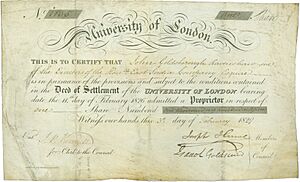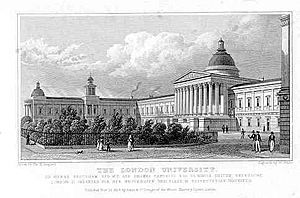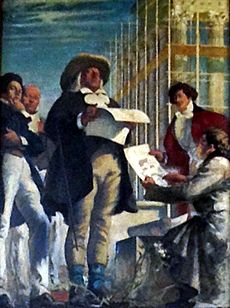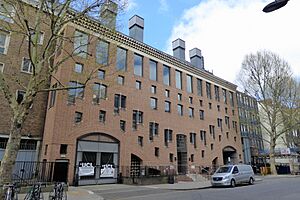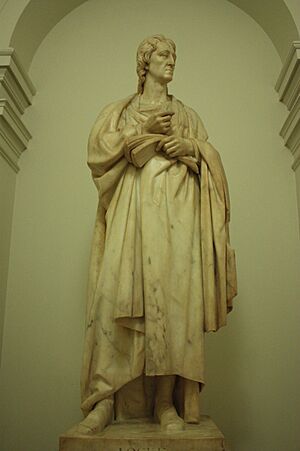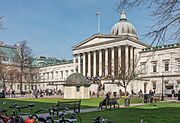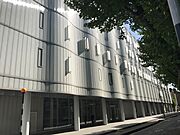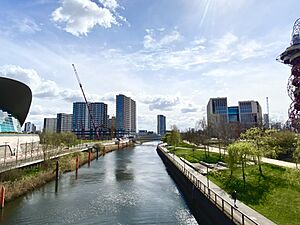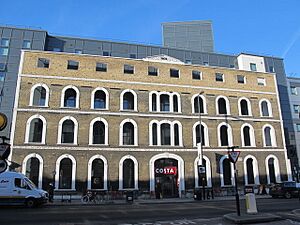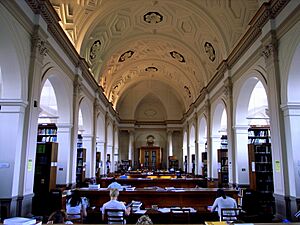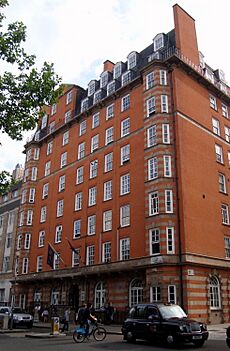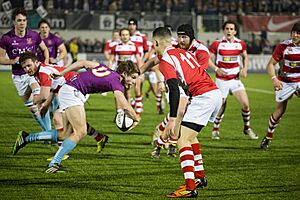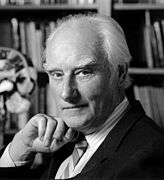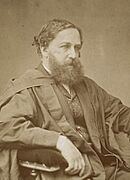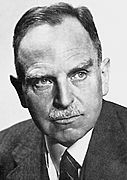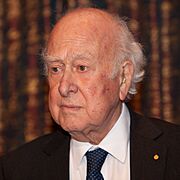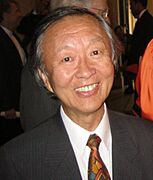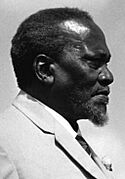University College London facts for kids
 |
||||||
|
Other name
|
UCL | |||||
|---|---|---|---|---|---|---|
|
Former names
|
London University (1826–1836) University College, London (1836–1907) University of London, University College (1907–1976) University College London (1977–2005; remains legal name) |
|||||
| Motto | Latin: Cuncti adsint meritaeque expectent praemia palmae | |||||
|
Motto in English
|
Let all come who by merit deserve the most reward | |||||
| Type | Public research university | |||||
| Established | 1826 (University status 2023) |
|||||
| Endowment | £174.8 million (2024) | |||||
| Budget | £2.029 billion (2023/24) | |||||
| Chair | Victor L. L. Chu | |||||
| Visitor | Sir Geoffrey Vos (as Master of the Rolls ex officio) |
|||||
| Chancellor | Anne, Princess Royal (as Chancellor of the University of London) |
|||||
| President and Provost | Michael Spence | |||||
|
Academic staff
|
10,350 (2023/24) | |||||
|
Administrative staff
|
6,655 (2023/24) | |||||
| Students | (2015/16) | |||||
| Undergraduates | (2015/16) | |||||
| Postgraduates | (2015/16) | |||||
|
Other students
|
895 (studying wholly overseas; 2021/22) | |||||
| Location |
London, England
51°31′29″N 00°08′01″W / 51.52472°N 0.13361°W |
|||||
| Campus | Urban | |||||
| Colours | Purple and blue celeste
|
|||||
| Affiliations |
|
|||||
University College London, also known as UCL, is a large public research university in London, England. It is part of the University of London and is one of the biggest universities in the United Kingdom. Many students from all over the world come to study at UCL.
UCL was founded in 1826 as London University. It was the first university in London. From the very beginning, it was different from other English universities like Oxford and Cambridge. UCL was the first to be completely non-religious. It allowed students to join no matter what their religion was.
In 1878, UCL became one of the first universities in the UK to accept women on the same terms as men. Over the years, UCL has grown by joining with many other schools and hospitals. These include schools for eye health, dentistry, and education.
UCL's main campus is in the Bloomsbury area of central London. It also has a new campus called UCL East in Stratford, near the Queen Elizabeth Olympic Park. The university has many famous graduates. These include the person who discovered the shape of DNA and members of the band Coldplay. UCL scientists have also made important discoveries, like finding five of the noble gases and inventing the vacuum tube.
Contents
History of UCL
A University for Everyone
UCL was founded on February 11, 1826. At the time, the only universities in England were Oxford and Cambridge. Both of these universities were linked to the Church of England. This meant that people from other religions, like Catholics or Jewish people, could not attend.
The founders of UCL wanted to create a university that was open to everyone. They were inspired by the ideas of a philosopher named Jeremy Bentham. He is often called the "spiritual father" of UCL. The university's motto is "Let all come who by merit deserve the most reward." This shows its goal of being open to all talented people.
When it first opened, it was called London University. It was the first university in England to have a professor of English and a professor of geography.
Becoming Part of the University of London
In 1836, the government created the University of London as an examining body. London University then became a college of this new university. Its name was changed to University College, London. For many years, it was one of the main colleges of the University of London.
UCL continued to be a pioneer. In 1871, the Slade School of Fine Art opened as part of the college. In 1878, UCL began admitting women to study arts, law, and science. This was a big step for women's education at the time.
Growing in the 20th Century
In 1907, UCL officially merged with the University of London. Its name became University of London, University College. During World War II, the university was badly damaged by bombs. The Great Hall and the dome of the main building were destroyed. The departments had to move to other parts of the country to stay safe.
After the war, the buildings were repaired. The university continued to grow. In 1976, it became more independent again and was formally named University College London. In the 1980s and 1990s, UCL merged with many medical schools and other institutes. This made it a much larger and more diverse university.
In the early 20th century, UCL was involved in the study of eugenics, a harmful and now discredited set of ideas about heredity. In 2021, the university formally apologized for its role in promoting these ideas.
UCL Today
In 2005, UCL was given the power to award its own degrees. This meant it was a university in its own right, while still being part of the University of London.
UCL has continued to expand. It opened a new campus, UCL East, at the Queen Elizabeth Olympic Park. The first buildings there opened in 2022 and 2023. The university also continues to merge with other important schools, like the UCL Institute of Education in 2014.
Campus and Buildings
UCL has campuses and buildings across London and beyond.
The Bloomsbury Campus
UCL's main campus is in the Bloomsbury area of central London. The most famous building is the UCL Main Building on Gower Street. It has a large dome and a classical-style entrance called a portico. This building was designed by William Wilkins.
Many other historic and modern buildings are part of the Bloomsbury campus. The area is a hub of learning, with many other universities and museums nearby. This includes the British Museum and the British Library.
- UCL buildings in Bloomsbury
UCL East Campus
UCL has a new campus called UCL East in Stratford, East London. It is located in the Queen Elizabeth Olympic Park, which was built for the 2012 London Olympics. The first buildings opened in 2022 and 2023. This campus has modern spaces for teaching, research, and student housing.
Other Locations
UCL has other sites around London and southeast England.
- The UCL Institute of Ophthalmology is next to Moorfields Eye Hospital.
- The UCL School of Management is located in a skyscraper at Canary Wharf.
- The UCL Observatory is in Mill Hill, north London.
- The Mullard Space Science Laboratory is in the countryside in Surrey.
Student Housing
UCL has 26 halls of residence, which are buildings where students can live. These halls provide rooms for about 7,000 students. The university guarantees a place for most first-year students who are new to London. This helps them settle into university life.
How UCL is Organised
UCL is a very large university. It is organised into different faculties and departments.
Faculties and Departments
UCL has 11 large faculties. A faculty is a group of related departments. For example, the UCL Faculty of Arts and Humanities includes subjects like English, history, and languages. The UCL Faculty of Engineering Sciences includes subjects like computer science and chemical engineering.
Each faculty contains many different departments, institutes, and research centres. In total, there are over 100 of these across the university.
| Faculty | Undergraduates | Postgraduates |
|---|---|---|
| Arts and Humanities | 2,684 | 1,169 |
| Bartlett (Built Environment) | 925 | 3,247 |
| Brain Sciences | 929 | 2,995 |
| Engineering Sciences | 4,373 | 3,913 |
| IOE (Education and Society) | 1,515 | 4,672 |
| Laws | 844 | 499 |
| Life Sciences | 2,632 | 1,676 |
| Mathematical and Physical Sciences | 3,927 | 1,609 |
| Medical Sciences | 2,356 | 1,717 |
| Population Health Sciences | 247 | 1,812 |
| Social and Historical Sciences | 4,130 | 2,542 |
Academic Life at UCL
Research and Discoveries
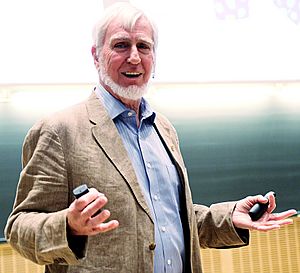
UCL is a world-leading research university. This means its staff and students work on discovering new things and solving important problems. The university receives a lot of money from grants to fund this research.
In a big review of UK university research in 2021, called the Research Excellence Framework (REF), UCL was ranked second in the country for its overall research power. This means it produces a very large amount of high-quality research.
Libraries and Museums
UCL has 18 libraries with over 2 million books. The Main Library is in the Wilkins Building and covers subjects like arts and history. The Science Library holds books on science, engineering, and maths. There are also special libraries for subjects like medicine, law, and education.
UCL also runs several museums that are open to the public.
- The Petrie Museum of Egyptian Archaeology has one of the world's most important collections of ancient Egyptian objects.
- The Grant Museum of Zoology and Comparative Anatomy is full of animal skeletons and specimens, including a rare quagga skeleton.
- The UCL Art Museum has a collection of art, including sculptures by John Flaxman that are displayed under the main dome.
University Rankings
UCL is considered one of the best universities in the world. In the 2023 QS World University Rankings, it was ranked 8th globally. It is consistently ranked in the top 10 in the UK and the top 25 worldwide. This shows its excellent reputation for teaching and research.
Student Life
Life at UCL is about more than just studying. There are many clubs, societies, and activities for students to join.
The Students' Union
The Students' Union UCL was founded in 1893. It is run by students, for students. It represents students' interests and provides many services. The union supports over 250 clubs and societies. These range from sports clubs to societies for drama, music, and debating.
Rivalry with King's College London
UCL has a long and friendly rivalry with King's College London, another major university in the city. In the past, students from the two universities would play pranks on each other. This often involved trying to capture the other university's mascot.
UCL's mascot was a wooden statue of a Scottish Highlander named Phineas. King's mascot is a lion named Reggie. The rivalry is now mostly celebrated through sports matches, especially the annual rugby varsity game.
Famous People from UCL
Many famous and important people have studied or worked at UCL.
- Francis Crick, who helped discover the structure of DNA.
- Alexander Graham Bell, who invented the telephone.
- Joseph Lister, a surgeon who pioneered the use of antiseptics.
- Jomo Kenyatta, the first President of Kenya.
- Charles K. Kao, who was called the "Godfather of broadband" for his work on fibre optics.
- Christopher Nolan, a famous film director.
- The members of the band Coldplay met while they were students at UCL.
So far, 32 Nobel Prize winners have been linked to UCL as either students or staff.
See also
 In Spanish: University College de Londres para niños
In Spanish: University College de Londres para niños
- List of universities in the UK


